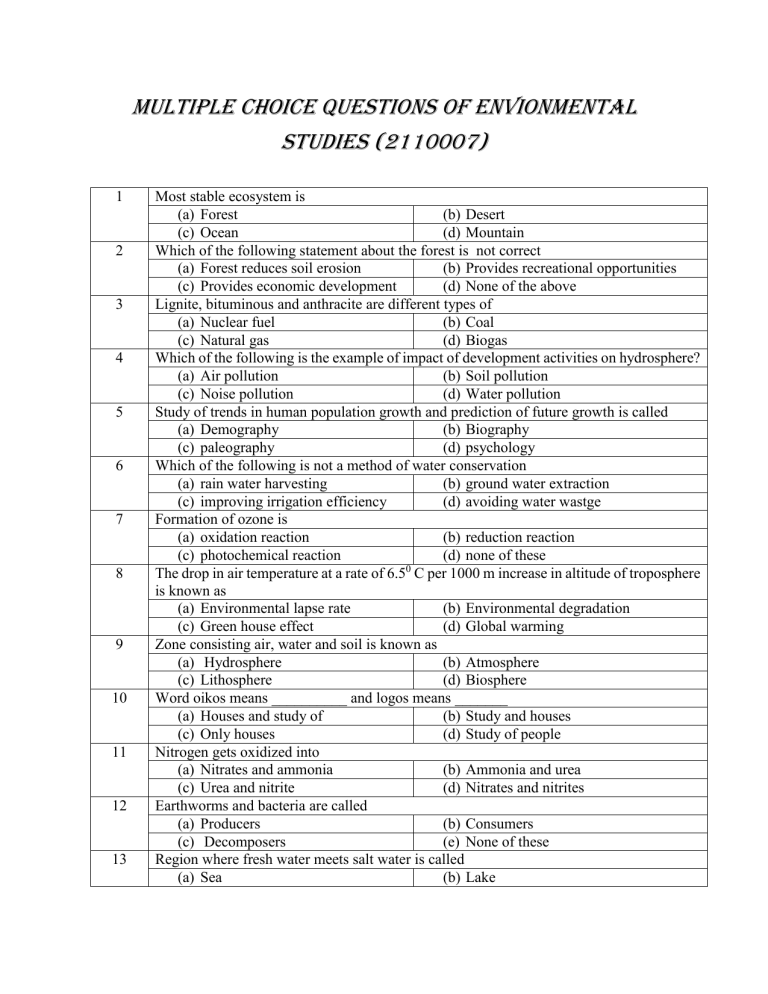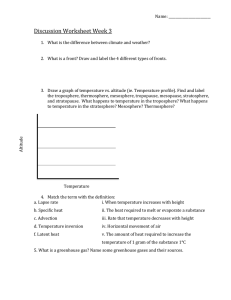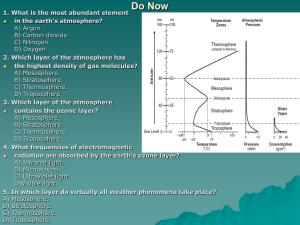
MULTIPLE CHOICE QUESTIONS OF ENVIONMENTAL STUDIES (2110007) 1 2 3 4 5 6 7 8 9 10 11 12 13 Most stable ecosystem is (a) Forest (b) Desert (c) Ocean (d) Mountain Which of the following statement about the forest is not correct (a) Forest reduces soil erosion (b) Provides recreational opportunities (c) Provides economic development (d) None of the above Lignite, bituminous and anthracite are different types of (a) Nuclear fuel (b) Coal (c) Natural gas (d) Biogas Which of the following is the example of impact of development activities on hydrosphere? (a) Air pollution (b) Soil pollution (c) Noise pollution (d) Water pollution Study of trends in human population growth and prediction of future growth is called (a) Demography (b) Biography (c) paleography (d) psychology Which of the following is not a method of water conservation (a) rain water harvesting (b) ground water extraction (c) improving irrigation efficiency (d) avoiding water wastge Formation of ozone is (a) oxidation reaction (b) reduction reaction (c) photochemical reaction (d) none of these 0 The drop in air temperature at a rate of 6.5 C per 1000 m increase in altitude of troposphere is known as (a) Environmental lapse rate (b) Environmental degradation (c) Green house effect (d) Global warming Zone consisting air, water and soil is known as (a) Hydrosphere (b) Atmosphere (c) Lithosphere (d) Biosphere Word oikos means __________ and logos means _______ (a) Houses and study of (b) Study and houses (c) Only houses (d) Study of people Nitrogen gets oxidized into (a) Nitrates and ammonia (b) Ammonia and urea (c) Urea and nitrite (d) Nitrates and nitrites Earthworms and bacteria are called (a) Producers (b) Consumers (c) Decomposers (e) None of these Region where fresh water meets salt water is called (a) Sea (b) Lake 14 15 16 17 18 19 20 21 22 23 24 25 (c) River (d) Estuarine The Ecological pyramid that is always upright (a) Pyramid of energy (b) Pyramid of biomass (c) Pyramid of number (d) None of these “Green house effect” with respect to global warming refers to(a) Cooling & moist condition (b) Warming effect (c) Increased rainfall & greenery (d) Desertification In India, Tropical rain forest occurs in(a) Jammu and Kashmir (b) Andaman & Nicobar (c) Uttar Pradesh (d) Himachal Pradesh Atomospheric ozone layer which protect us from UV-B & C is getting depleted most by addition of(a) Chloro flurocarbon (b) Carbon monooxide (c) Carbon dioxide (d) Sulpur dioxide 5th June is observed as (a) World forest day (b) World environment day (c) World wildlife day (d) World population day st 21 March is observed as (a) World forest day (b) World environment day (c) World wildlife day (d) World population day Noise is measured using sound meter and the unit is (a) Hertz (b) Decibel (c) Joule (d) Sound Important abiotic factors in ecosystems include which of the following? (a) temperature (b) water (c) wind (d) both (a) and (b) 2) All of the following statements about ecology are correct except: (a) Ecology is the study of the (b) Ecology is a discipline that is interactions between biotic and independent from natural selection and abiotic aspects of the environment evolutionary history (c) Ecologists may study populations (d) Ecology spans increasingly and communities of organisms. comprehensive levels of organization, from individuals to ecosystems 4) Which of the following are important biotic factors that can affect the structure and organization of biological communities? (a) nutrient availability, soil pH, light (b) precipitation, wind, temperature intensity (c) predation, competition, disease (d) all of the above The term “Environment” means (a) Sum total of all conditions that the (b) A beautiful earth life and development of all organisms on earth (c) Earth and water (d) A combination of plants and animals Elements of environment are (a) Nitrogen, Carbondioxide, Oxygen (b) Nitrogen, Oxygen, Ozone (c) Carbondioxide, Oxygen, Ozone 26 27 28 29 30 31 32 33 34 35 36 37 38 39 (d) Lithosphere, Atmosphere, Hydrosphere and Biosphere The term Environment is derived from an old French word “enviro” means (a) Outside (b) Surroundings (c) Inside (d) Biotic community Hydrosphere includes (a) Animals (b) Soil (c) Plants (d) Water bodies Area of land, water and air where the life exists is called (a) Biosphere (b) Lithosphere (c) Atmosphere (d) Hydrosphere Atmosphere may extents to a height of about following kms above the earth surface (a) 80 km (b) 8000 km (c) 800 km (d) 8 km The layers of atmosphere consists of (a) Troposphere, Stratosphere, (b) Hydrosphere and biosphere Mesosphere and Temperature (c) Lithosphere and Hydrosphere (d) Biosphere and Hydrosphere Lowest layer of atmosphere is called (a) Thermosphere (b) Stratosphere (c) Troposphere (d) Mesosphere Troposphere has altitude range of (a) 8 to 18 km from earth surface (b) 50 km from earth surface (c) 800 km from earth surface (d) 80 km from earth surface The layer of atmosphere containing much of ozone gas is (a) Thermosphere (b) Stratosphere (c) Troposphere (d) Mesosphere The coldest layer of temperature having minimum temperature range of -950 C is (a) Thermosphere (b) Mesosphere (c) Stratosphere (d) Troposphere Thermosphere has two layers of (a) Ionosphere and Exosphere (b) Stratosphere and Troposphere (c) Mesosphere and Troposphere (d) Mesosphere and Stratosphere The layer which provides ideal site for flying of jet planes is (a) Thermosphere (b) Stratosphere (c) Mesosphere (d) Troposphere As per IPAT equation impact of environment degradation depend (a) population, Affluence and (b) Population and industrialization technology (c) Urbanization and poverty (d) Population, Pollution Scientific study of the interactions of organisms with the physical environment is called (a) Ecosystem (b) Ecology (c) Environment (d) Trophic stricture The three major living components of an ecosystem are 40 41 42 43 44 45 46 47 48 49 50 51 52 53 (a) Producers, consumers and (b) Producers, Autotrophs Decomposers Decomposers (c) Heterotrophs, Consumers and (d) Detritivores, Consumers Reducers Phototrophs The green plants are also called (a) Producers (b) Consumers (c) Reducers (d) Detritivores Example of omnivores is (a) Lion (b) Hawk (c) Human (d) Snake The most important organisms of an ecosystem are (a) Herbivores (b) Producers (c) Carnivores (d) Protozon Consumers are also called (a) Photoautotrophs (b) Saprotrophs (c) Heterotrophs (d) Reducers Sequence of eating and being eaten in a ecosystem is called (a) Food web (b) Natural cycle (c) Ecological Pyramid (d) Food chain Detritus food chain starts from (a) Green plants (b) Grass (c) Dead organic matter (d) Phytoplankton Nutrients are recycled in ecosystem by (a) Biogeochemical cycle (b) Energy flow (c) Producers (d) Consumers The flow of energy is, (a) Oneway (b) Cyclic (c) Linear and oneway (d) None of these Biodiversity means (a) The living natural resources (b) Land and forest (c) Oceans and sea (d) Atmosphere Food chain always starts with (a) Respiration (b) Transpiration (c) Nitrogen fixation (d) Photosynthesis The ecological pyramid always starts with the following at the base (a) Decomposer (b) Producer (c) Consumer (d) None of these Hydrological cycle provides us (a) Fresh water (b) Nitrogen (c) Carbon dioxide (d) None of these Gaseous nitrogen can be used by plants only after the process of (a) Nitrogen cycling (b) Nitrogen fixation (c) Ammonification (d) Nitrifications Conversion of ammonia to nitrite and then nitrate is called (a) Nitrogen fixation (b) De nitrification and and 54 55 56 57 58 59 60 61 62 63 64 (c) Nitrification (d) Ammonification The loss of water from plants and tree leaves is called (a) Precipitation (b) Respiration (c) Evaporation (d) Transpiration Which of the following is a non-renewable resource? (a) Coal (b) Forest (c) Water (d) Wildlife Deforestation generally decreases (a) Rainfall (b) Soil erosion (c) Draught (d) Global warming Chipko movement was started to conserve (a) Forests (b) Grasslands (c) Deserts (d) Soil Fossil fuel and metallic minerals are (a) Renewable resources (b) Non-renewable resources (c) Inexhaustible (d) None of these Examples of conventional type of renewable resources may be (a) Plants (b) Wild life (c) Aquaculture (d) All of these The subsurface sources of water is (a) River (b) Dug well (c) Stream (d) Ocean Afforestation is necessary for (a) Soil conservation (b) Soil erosion (c) Well control (d) Low humidity In the hills forest cover is affected by, (a) Overgrazing by cattle (b) Soil erosion (c) Leaching of soil (d) Soil pollution Air pollution is caused by (e) Insecticides (f) Sewage (g) Smoke (h) Loud speakers If waste materials contaminate the source of drinking water which of the following diseases will spread? (f) Typhoid (h) Anaemia 65 (e) Scurvy (g) Malaria When trees are cut, amount of oxygen (f) increases (h) remains same 66 (e) decreases (g) both (a) and (b) 71% of earth surface is covered with: (e) land (g) water (f) air (h) coal 67 Which of the following is secondary pollutant (f) CO (h) SO2 68 (e) CO2 (g) O3 Carbon monoxide is a pollutant because (f) It inhibit its glycolysis (h) React with hemoglobin 69 (e) It react with O2 (g) Make nervous system inactive All are particulate pollutants expect 70 (e) Dust (f) ozone (g) soot (h) smoke Major cause of increment in population growth 71 (e) decrees in birth rate (g) illiteracy Main objective of family welfare program is 72 (e) population control (f) disease control (g) a & b (h) none of the above The sudden increase\e in the population of the species is 73 (e) population growth (f) population explosion (g) over population (h) all above According to Thomas Malthus human population increase in (f) geometric ratio (h) all above 74 (e) arithmetic ratio (g) exponension ratio Which of the following is an air pollutant (f) CFC (h) oxygen 75 (e) ozone (g) Carbon dioxide Noise is 76 (e) loud sound (f) constant sound (g) unwanted sound (h) slow sound Which of the following are major causes of land degradation? 77 (e) soil erosion (g) water logging Biochemical oxygen demand means (e) industrial pollution (g) polluting capacity of effluent 78 Eutrophication means (f) decrees in mortality rate (h) none of the above (f) deforestation (h) desertification (f) air pollution (h) dissolved O2 needed by microbes to decompose organic waste (e) thermal change in water 79 (f) filling up of water body with aquatic due to extra nourishment (g) solid waste (h) none of the above The main components of photochemical smog is 80 (e) water vapour (f) sulphur dioxide (g) oxides of nitrogen (h) all of the above The TAJ MAHAL at AGRA may be damaged by (e) sulphur dioxide (g) hydrogen (f) chlorine oxygen 81 Sound becomes hazardous noise pollution at decibels (f) above 80 (h) above 120 82 (e) above 30 (g) above 100 Effect of noise pollution is mainly on, (f) chemical factor (h) all of the above 83 (e) physical factor (g) biological factor The important component of environment is (f) Lithosphere (h) all of the above 84 (e) Biosphere (g) Atmosphere The pollutant free energy resource are, 85 (e) coal (f) nuclear power (g) petroleum (h) solar energy The atmosphere of big cities is polluted most by, 86 (e) household waste (f) radioactive falls out (g) automobile exhausts (h) pestricides The concentration of which gas is highest in our environment? 87 (e) Oxygen (f) Hydrogen (g) Nitrogen (h) Carbon dioxide Which of the following are the example of Municipal and industrial discharge pipes 88 (e) Nonpoint sources of pollution. (f) Violations of the Clean Water Act. (g) Point sources of pollution. (h) Irrigation. Which of the following is not a major source of groundwater contamination? (e) agricultural products (g) underground storage tanks (f) landfills (h) all of the above are major sources of groundwater contamination








